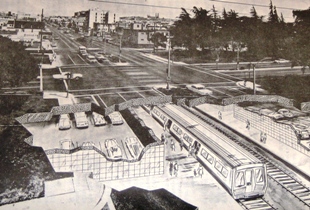Why don't we remove the freeways?
Yesterday I pointed out
a great article in Scientific American documenting the plain, simple reality that
removing freeways improves traffic flow in urban areas. That article leads with the example of an elevated freeway in Seoul, Korea that was removed, and the improvement in traffic flow that resulted.
Reading up a little more, I found
an excellent website devoted to real-world examples of urban freeways that have been nixed.
The Preservation Institute of Berkeley, CA tells the whole story of the
Cheonggye Freeway. From river to freeway and back again in less than half a century, the Cheonggye is a remarkable case, but freeway removal in cities around the world are strikingly similar.
Here in SF we have two good cases where freeways were closed and the sky remained firmly up. The
Embarcadero and
Central Freeways were removed after much hair-pulling and hand wringing, and replaced with surface streets that have proven to be wildly successful.
View Larger MapHere's a little map of the scars across San Francisco caused by elevated freeways. Blue represents extant freeway, green represents those removed.
These monstrosities cut off neighborhoods and
blight the area for blocks around. This map doesn't even highlight those traffic sewers that some of our city streets have been turned into in a vain effort to whisk people on and off these concrete octopuses. Streets like Alemany Blvd, San Jose Ave and Division St.
If we can see that these misguided structures cause tangible problems, and we know that removing them improves traffic flow while eliminating those problems, then why the hell don't we tear them all down?
 Even if it is just temporary. As you've probably heard by now, five city agencies have announced that they will change the traffic patterns on Market Street on a trial basis starting September 29th and lasting at least six weeks, according to the
Even if it is just temporary. As you've probably heard by now, five city agencies have announced that they will change the traffic patterns on Market Street on a trial basis starting September 29th and lasting at least six weeks, according to the 






